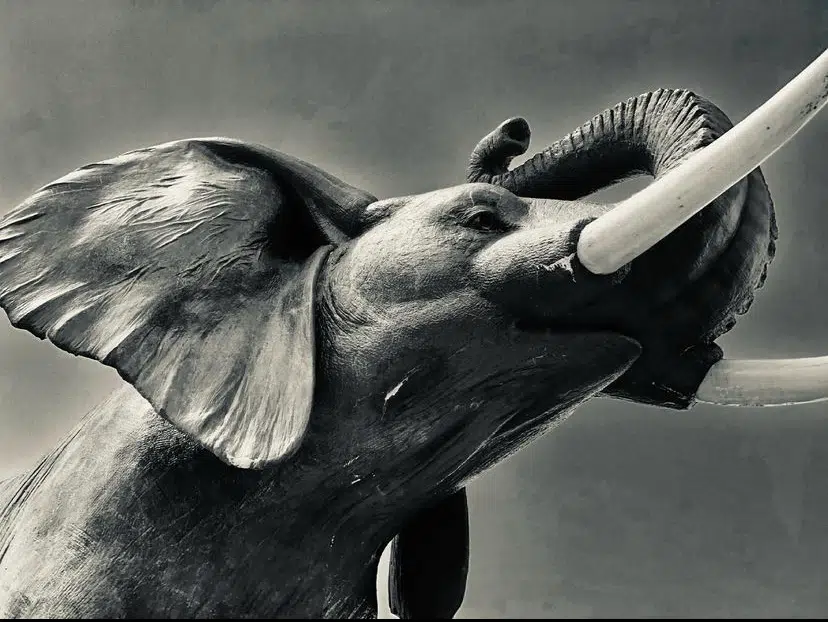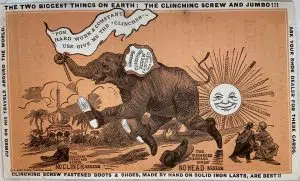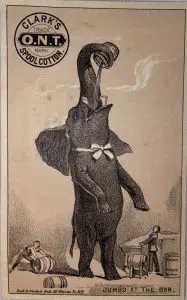Jumbo, the elephant famous for his size as American showman P.T. Barnum called him the “largest animal in the world,” met his end in Canada while on a circus stop in St. Thomas, Ontario on Sept. 15, 1885. But his story doesn’t start there.
It begins back in Africa, presumably Ethiopia, where he was captured at a very young age.
“There was quite a trade in live animals there, specifically an interest in Europe with the development of zoos,” says St. Thomas city councillor and former Elgin–Middlesex–London MPP Steve Peters. “Jumbo was captured by these animal traders and taken to the Paris Zoo around 1861.”
A rather small elephant at the time, Jumbo was not a big attraction to the zoo so, about four years later in 1865, he was traded for a rhinoceros and sent to the London Zoological Gardens in England.
Predominantly, elephants in captivity have been Asian elephants. An Asian elephant is a much easier elephant to train and domesticate versus an African elephant, such as Jumbo. The African elephant has and continues to retain more of a “wild side,” according to Peters.
The origin of Jumbo’s name is also still unknown. The first reference to the word appears in the Oxford Dictionary in 1820, used as an adjective to describe something clumsy.
However, upon his arrival to the London Zoological Gardens, Jumbo was put in charge of a keeper named Mathew Scott, who virtually spent the rest of his life assigned to that role.
“We hear a lot about dog whispers and in some ways Matthew Scott may very well have been an early form of an animal whisperer because Jumbo and Scott had this really unique bond of friendship,” says Peters. “I look at it in a lot of ways like a brother relationship. An odd relationship, but it was one of mutual respect for one another”
Due to this unique bond, Jumbo started to grow. Evidently due to a similar growing love of sweet treats.
“Jumbo had a real sweet tooth, and he liked sweet buns. But Jumbo was also known to indulge in a little bit of alcohol as well,” says Peters.
“I’m not sure how much alcohol they gave him but it was something that was done to keep him calm,” says Megan Pickersgill from Railway City Tourism.
With an extensive diet, Jumbo was never deprived of any food and enjoyed the attention received by those who visited the zoo.
The public was fascinated by the gigantic animal. Even catching the attention of Winston Churchill, Queen Victoria and her children who all got to ride on Jumbo’s back.
But, as Jumbo continued to grow and mature, his calming nature started to become more violent.
“I think puberty might be the best way to describe what Jumbo was entering,” says Peters. “He was known to smash the doors, and one interesting thing about Jumbo is that he never had tusks. He was always breaking them off.”
During this time, famous showman P.T. Barnum reached out to the London Zoo in the hopes of purchasing Jumbo for his “Greatest Show on Earth.”
To his surprise, the zoo agreed to sell Barnum the elephant. The final deal broke down to $10,000 and Barnum was to be responsible for bringing Jumbo to America.
Peters says this deal caused huge uproars across England.

1883 Newspaper advertisement for P.T. Barnum’s “Greatest Show on Earth,” Jumbo’s first appearance in Canada. (Steve Peters)
“There was this huge uproar that even the Parliament of the United Kingdom got involved as to how to stop the sale of Jumbo the elephant.”
However, the deal was finalized and Jumbo was sent to America. The transporting process lasted a couple months and cost Barnum around $30,000 as Jumbo refused to go willingly. But, as anticipation grew for Jumbo’s arrival in the United States, within a few days Barnum had recouped all his expenses.
Still mourning the loss of their beloved elephant, concerns sparked back in England about a female elephant, Alice, who was said to be Jumbo’s wife.
“Everybody kept saying that they shouldn’t be separated but the two of them hardly ever met, and were not even very good friends,” says Peters.
But still a story of separated, scorned lovers was painted, which created the famous children’s poem titled ‘Jumbo and Alice’.
Jumbo said to Alice, I love you,
Alice said to Jumbo, I don’t think you do.
For if you really loved me, as you say you do,
You’d never go to Yankee Land and leave me in the zoo.
But Jumbo did leave the zoo and began his stardom in 1882 in P.T. Barnum’s “Greatest Show on Earth” where, it’s said, he brought the largest crowds in the history of the circus.
Jumbo’s height was never officially recorded, as Barnum would never allow Jumbo to be measured. His height was an estimated 11 ½ feet, weighing about 7 imperial tons.
Barnum planned to take his circus to England, hoping people would fill his tents to see Jumbo again. But a terrible accident, in 1885, put that dream to rest.
On Sept. 15, the Barnum and Bailey circus was in St. Thomas, Ontario, southwest of London. The performance ended and Mathew Scott, who followed Jumbo to the circus, was escorting him and a dwarf elephant by the name of Tom Thumb toward their cages.
They were following two parallel railway tracks, one lined with box cars and the other open for the movement of freight trains. But the circus had been told that there were no trains scheduled for the evening.
To their surprise, an unscheduled freight train started to approach. Scott tried to move the elephants down into a nearby ditch, but failed. Jumbo started to run away from the train, with Tom Thumb following close behind.
The small elephant was first struck and tossed into the ditch, breaking his leg. Seconds later, the locomotive hit Jumbo in the back of his legs, forcing his head into the tracks where one of his tusks pierced his brain. Jumbo passed away half an hour later, with Scott never leaving his side.
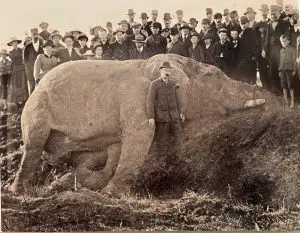
Mathew Scott (front) standing in crowd of people gathered around Jumbo after freight train accident – Sept. 15, 1885.
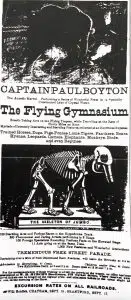
Newspaper advertisement of the “Greatest Show on Earth” with the parade of ‘The Skeleton of Jumbo’ (Provided by Steve Peters)
“It must have been quite a sight to see,” says Peters. “But P.T. Barnum, ever the exploiter of any incident, later on changed the story when telling the public.”
Barnum’s version of the horrific accident was rewritten to say that Jumbo saw the ‘iron horse’ coming down the tracks and he saved his friend Tom Thumb by picking him up in his trunks and throwing him into the ditch. Then charging the train head on, knocking it off the tracks.
“While the train did get knocked off the tracks, it wasn’t in the way that Barnum described,” says Peters.
Jumbo’s body was brought to a local butcher’s shop where he was taxidermied, according to Barnum’s orders. The skin was pickled by a local packing company and his body was stuffed so that Jumbo could continue traveling with the circus.
Jumbo was later donated to Tufts University in Medford, Massachusetts where they adopted him as their mascot. Jumbo remained at the university until 1975 when the remains were destroyed in a fire.
The bones still exist today in the Museum of Natural History in New York City but were last displayed in 1993.
Mathew Scott was “never the same after Jumbo died,” according to Peters. Scott died in 1918 in Bridgeport, Connecticut, the hometown of P.T. Barnum, and remains buried in an unmarked grave.
After the horrific accident, rumours about Jumbo’s death started to rise claiming it had been engineered because of his failing health. This led to a conspiracy that Jumbo’s death was staged because a sick and dying elephant could leave the circus, specificlly Barnum, open to accusations of animal cruelty.
But after a later examination of the bones, it was ruled that no illness was ever present and that, along with his tusk piercing his brain, abrasions along Jumbo’s rear flank caused massive internal trauma that also led to his death.
Peters believes that Barnum orchestrating the death of his most popular circus attraction would be “foolish” of him to do.
“If P.T. Barnum did mistreat Jumbo in any way; it was the exploitation of how much money he could make off of him…The constant traveling and walking even just up the lift to his train car would wear on him overtime. But Jumbo was cared for, especially my Barnum because he was his pocket book.”
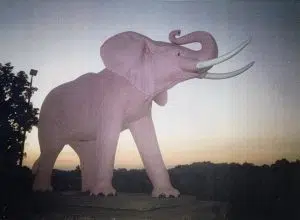
‘Pink’ Jumbo the elephant monument at west end of St. Thomas, Ont., Covered in treatment solution (Image provided by Steve Peters)
To mark the 100th anniversary of Jumbo’s death, a large monument was erected at the West End of St. Thomas. With a few marginal errors to the design including size, large tusks, and five toes on each foot, even though no elephant in recorded history has more than four, the monument still remains as a staple in the community.
“I would say he’s our most popular tourist attraction to this day,” says Megan Pickersgill of Railway City Tourism. “It’s a popular roadside attraction and we even have murals around the city that commemorate the life of Jumbo as well.”
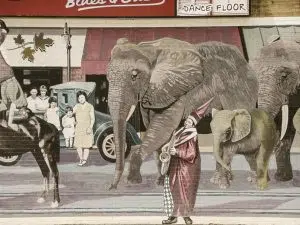
‘Elephant Parade’ by Paul Austin mural on 8 Manitoba Street, St. Thomas, Ont. (Railway City Tourism)
According to Peters, the city of St. Thomas has commemorated the life of Jumbo in many other ways.
“We have a local entrepreneur that sells these jumbo sweatshirts. We have a brewery that produces a couple different brands of beer that are related to Jumbo and his own love of alcohol. And the name continues to live in our vocabulary.”
“Whether it’s ‘Jumbo Joe Thorton’, the hockey player, or the jumbotron at the Rogers Centre in Toronto, or a jumbo hot dog, the name is synonymous with something big, and like Jumbo, he will continue to be a big, popular attraction for St. Thomas down the road.”
In the Hindu tradition, elephants bring you the best of luck when they face the East, hence why his monument faces the East today.The tale and tragedy of Jumbo the elephant remains in the lives of those in and around St. Thomas. But as Peters explains, Jumbo remains in a more literal way than you may think.
“If you take the map of Ontario and turn the map with Windsor to the North, then Southwestern Ontario will then look like an elephant… One “leg” goes down on the Niagara Peninsula, his back is the Lake Huron shore, his tail is Tobermory, and we won’t say what part of the anatomy Owen Sound is but Jumbo’s heart is in St. Thomas.”




